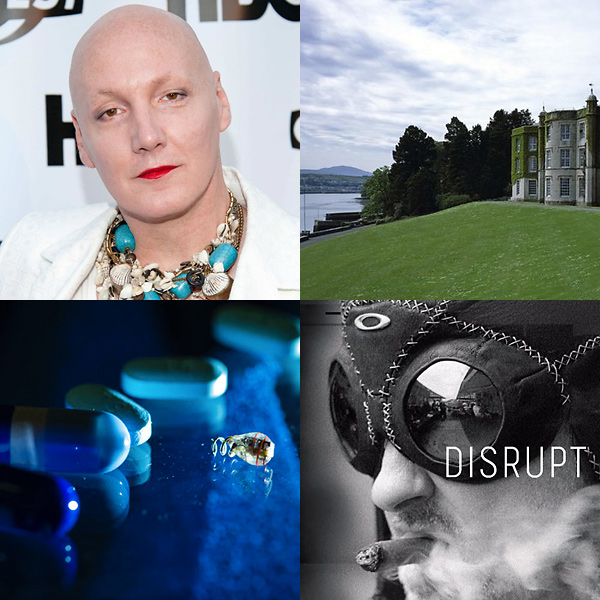Link About It: This Week’s Picks
Crystal computers, NYC Club Kids, drinkable sunscreen and more in our weekly look at the web


1. Disruptive by Design
Telling the story of Oakley, from its humble beginnings to becoming one of the world’s leading eyewear innovators, the newly released “Disruptive by Design” is a
brand film of rather impressive proportions. Recapping its most
impactful designs since the brand launched in 1975, the
Kevin Spacey-narrated short film details the ins and outs of building a
successful design-focused business, proving what’s possible when a company pushes norms out of their line of vision.
2. Google+ Photos’ Stories
With smartphones’ ability to capture high-quality images easily and quickly, and our collective (albeit strange) impulse to record every moment of every day, many of us are drowning in photos. Enter “
Stories,” a new Google+ Photos feature that helps categorize images into logical albums—from weekends away to birthday parties—and (if Google+ auto-backup is installed) it all happens automatically. Incredibly, it doesn’t even rely on location data; recognition works similarly to a Google image search. Says Google’s Ben Eidelson (a product manager for Google+ Photos), “What we’re trying to do is think of photos as moments. This is a moment in your life that you want to do something with.”
3. Drinkable Sunscreen
With summer—finally!—kicking off this weekend, Osmosis Skincare has come up with a potential solution for those who forget to slip, slop and slap: drinkable sunscreen. Harmonized H2O UV claims that it makes its water molecules “vibrate” on the skin to cancel out 97% of UVA and UVB rays, though it has no hard science or dermatologists to back up the claims. While adding this to our list of things that sound too good to be true (along with the waterproof spray NeverWet), we hope that products like this bring attention to the issue that the cosmetics and beauty industry have much more lax standards than food and drugs.
4. Sea-Powered Home Heating
As the shift toward renewable energy becomes more widespread, engineers are sourcing power from ever more inventive sources. The latest is based in the UK, where scientists have figured out a way to generate heat from seawater. The money-saving solution relies on a heat exchanger that operates similarly to a refrigeration system. While many conditions must be met for the option to be cost-efficient, many thought-leaders see this technology—which can be used to draw heat from the air as well as the ground—as a viable future option for green energy.

5. How to Charge Your Microimplants
From cybernetics and location tracking devices to vital-sign reading implements, we have always envisioned microimplants as part of our future. Researchers at Stanford are bringing them one step closer to reality. Having developed a technology for wireless charging through near-field and far-field electromagnetic waves, an object such as a pacemaker can be inserted into the body without an internal charging system. This drastically minimizes size and opens the door for an entire world of medical (and non-medical) implants.
6. High and Low
Sure, Mariah Carey can go high, but how high? G7 to be exact—more than an octave above Thom Yorke’s highest note. In the recording studio, Justin Timberlake, Bob Marley and Lady Gaga peak at B5. The website Concert Hotels has put together an interactive chart that compares the vocal ranges of well-known singers and even tells you the song in which the artists reach their highest and lowest note. Spoiler alert: Axl Rose has the widest vocal range in the sample while Taylor Swift comes in second to last.
7. Irrational Computing
Berlin-based artist Ralf Baeker recently proved that computing isn’t all about technology. Baeker cleverly incorporated primitive quartz crystals and industrial waste in his latest piece, “
Irrational Computing” which will be on display next month at China’s international Triennale of New Media Art. The project doesn’t function in the same way as a modern machine would do, but instead speaks to early radios that were created from raw crystal specimens and the silicon used in CPUs. In essence, the artist reveals the connections between man and machine in a beautiful display that’s as thought-provoking as it is poetic.
8. Party Monsters Grow Up
When Michael Alig was released from prison this week after serving a sentence for murdering a fellow club kid in the mid-’90s, two of his party friends from back in the day were there to pick him up. A profile on the prominent members of NYC’s club scene as they are today reveals that all party monsters do grow up, though some stay quite close to their roots. A few have ventured into styling and fashion design, many have become established artists, and others carry on clubbing—some professionally. Perhaps not so unexpectedly, there’s a taut link between the upper echelon of party scenes and the greater creative community.
Link About It is our filtered look at the web, shared daily on Twitter and published weekly every Saturday morning.










